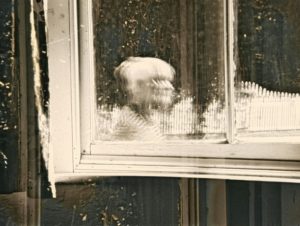The other week, I once again had the thrill of attending the Media City Film Festival in Windsor, Ontario. Its 22nd iteration this year was a special one for me. Media City presents experimental and artist films from around the world, insistently focused on making this highly personal and challenging work as accessible as possible for anyone who wants to experience it: good presentation, pay-what-you-can ticketing, and as many artists as possible in attendance to discuss their work, not only in Q&As but also in the bar next door after the programs, and maybe in the festival office after the bar closes.
Our own Full Aperture series, for me, is inspired primarily by my experiences at Media City. At any rate, it’s a small and highly dedicated operation and there was no festival last year, so it felt extra gratifying to return this year to get the distinctive flavor of South Detroit.
This year’s festival was slightly abbreviated but still reached sublime heights of programming. Opening night, as always, occurred in Detroit, as Media City is one of many presenting organizations along the border that are trying to cross-pollinate as much as possible. Opening night also, as always, featured music. This year, the beautifully restored Detroit Film Theater in the Detroit Institute of Art hosted a sublime performance by avant-garde violinist Malcolm Goldstein and a program of films by Yoko Ono. Ono’s artistic persona comes with a lot of preconceptions, but her films were delightful and frankly a joy to see: simple ideas that encourage the viewer to see their subjects from new angles. A match being blown out. A fly crawling across a body. A camera ascending high into the air on a balloon.
A retrospective program featured the distinctive and often breathtaking Soviet-era 35mm documentaries of Armenian auteur Artavadz Péléchian. The rest of the program was similarly analog: with the exception of digital explorations like Sky Hopinka’s Standing Rock documentary Dislocation Blues, the vast majority of titles showing on 16mm or 35mm. Standout work by emerging filmmakers like Jennifer Saparzadeh (Nu Dem) and Manuela De La Borde (As Without So Within) revealed new and surprising ways of constructing and exploring. The brilliant Montreal-based filmmaker Daïchi Saïto brought Engram of Returning, an overwhelmingly intense abstract and rhythmic explosion in 35mm. And so on.
One thing I love about Media City is that, being made up mostly of non-narrative short films, it requires a very particular programming sense to juxtapose films in ways that are barely articulable, but that make the overall experience stronger. In certain moments, one can feel the entire weight of the program in a new or newly intense way, and it’s an extraordinary thing. Such a moment occurred for me in a program featuring Alexandre Larose’s stunning multi-exposure portrait Saint Bathans Repetitions, followed by Els Van Riel’s Fugue: A Light’s Travelogue, a very quiet 27-minute meditation based on a filmed multi-projector performance of educational films on scientific discoveries relating to light. After being floored by Saint Bathans, I had descended into the perfect mental state to absorb Fugue to the max. Creating moments like these are why we put as much work as we do into presenting films.
But the very best of the fest for me was a work by Peter Hutton, the Detroit-born filmmaker who died last year. I haven’t seen most of Hutton’s films, and the ones I have seen are mostly digital copies. But I was completely blown away by Lodz Symphony (1993), which is a 20-minute, black-and-white, silent film with no camera movement or zooms or any frills whatsoever. It’s made up of street and interior shots of the Polish city, and every aspect of composition, duration, and editing is perfect, for every shot. Online viewings cannot capture what is masterful about the film, and so I have to wait to see it again. A bittersweet longing. – TB




